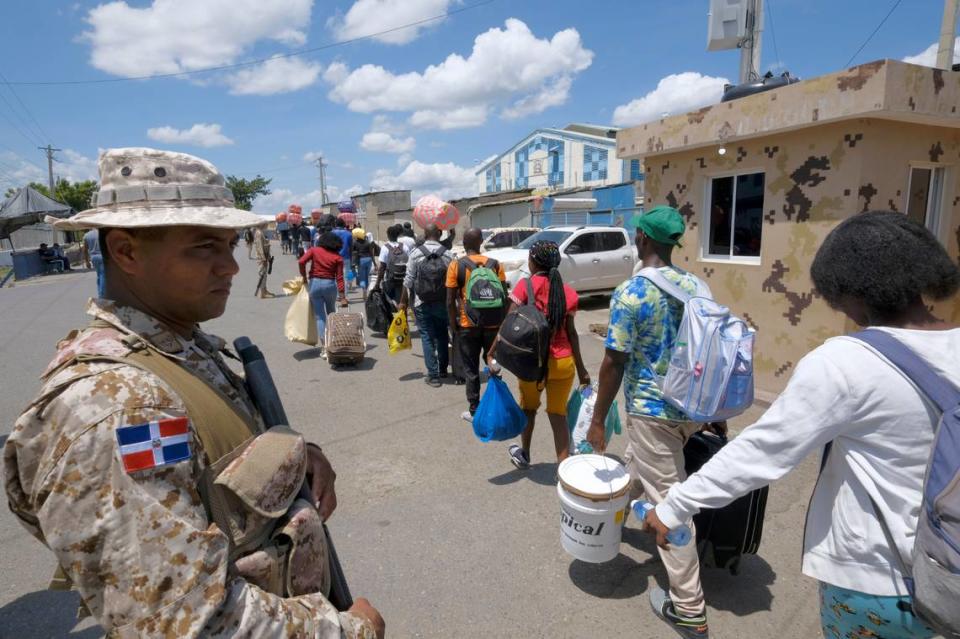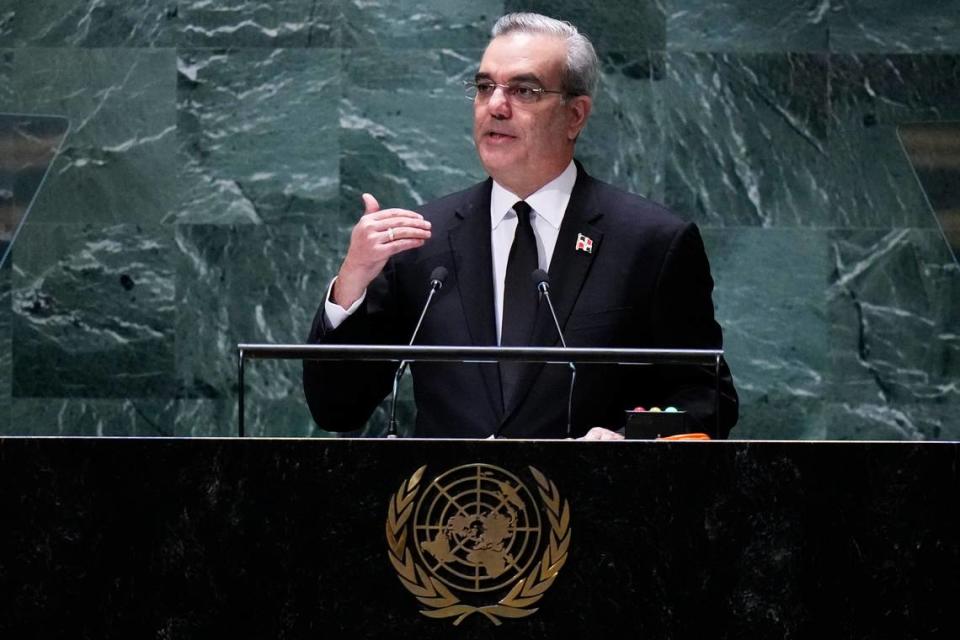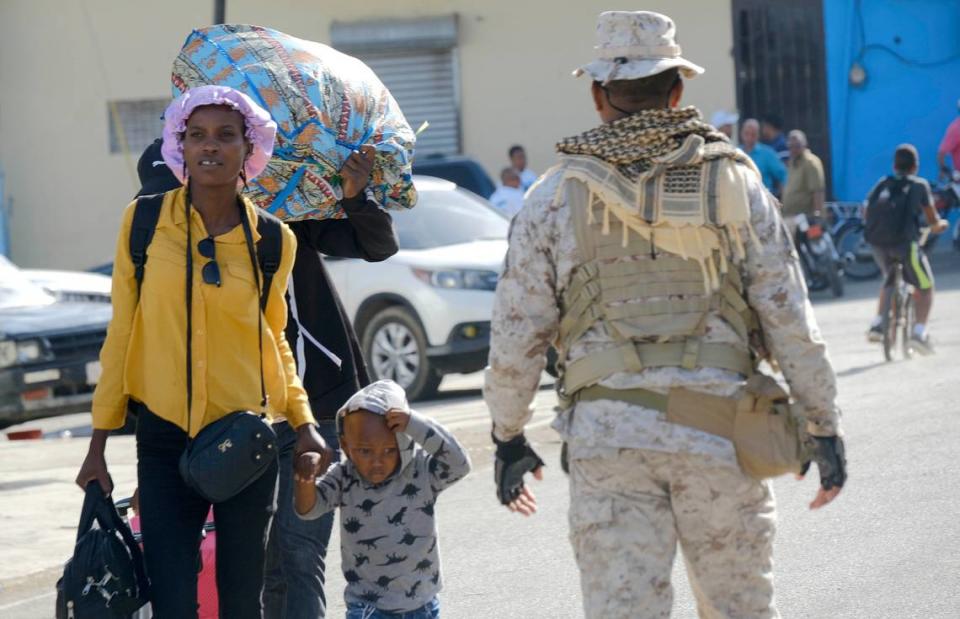‘This is a fight for our survival’: Dominican Republic canal conflict unites Haitians
The young Coral Springs teacher was leading a raucous school bus in cheers.
But the bus was not in South Florida. It was traveling through the Haitian hinterlands headed to the border with the Dominican Republic, and the people on the bus were cheering back as she yelled: “We are on the way to the canal!”
The busload was responding to Bertrhude Albert, 33, as she stood in the aisle wearing a red-and-white T-shirt that read “Our Teachers Are Heroes” in Haitian-Creole.
Albert, looking straight into a video camera, announced that $18,597 had been raised in 12 hours to build the canal in northeast Haiti.
Then, adopting the motto on Haiti’s coat of arms, L’Union fait la force — Unity makes strength —Albert rallied her team in an outpouring of Haitian solidarity and pride before yelling, “Let’s go build that canal.”
Arriving at the site in the city of Ouanaminthe near the border with the Dominican Republic, Albert, 33, tied a Haitian flag around her neck, and toured the canal, escorted by the two security teams standing guard over the mammoth structure, now at the center of an international crisis over access to water.
“The unity is so inspiring,” Albert said as Haitian flags blew through in the wind and crowds of workers, some of them standing on cinder blocks, used their bare hands to excavate a ditch.
The government of the Dominican Republic has shut down the 220-mile border with Haiti, complaining about the canal that Haitians are building on the Massacre River, saying that it is badly engineered and diverting water vital to both countries for agricultural irrigation.
As the two countries’ positions continue to harden, the conflict is reigniting centuries-old tensions between the two neighbors and firing up Haitians, including those living abroad, at a time of hyper-polarization among them.
In the past week thousands of Haitians, who share the island of Hispaniola with the Dominican Republic, have been making their way to the river to see what the fuss is about and to lend their support to the canal’s excavation. Some work while others provide supplies, and Haitian living abroad are raising and sending money to help people like Albert support the labor.
“When I went there yesterday, they were building the canal without funding and on credit,” she said. “I actually went to the place and paid for the materials they got on credit because they said, ‘We can’t stop this momentum.’ ”
Like most Haitians, Albert, who left Haiti when she was 8 and has a Ph.D in agricultural education from the University of Florida, has been following the conflict, which led to Dominican President Luis Abinader to shut down the entire air, land and sea border on Friday over the canal’s construction.
Albert runs a Fort Lauderdale-based non-profit, P4H Global, that she founded to train teachers across Haiti. Sitting in the organization’s office in Cap-Haïtien, she realized that she needed to go to the border and contribute what she could.
“Even if it was just gonna be $300, I wanted to give my personal contribution and see it for myself,” she said, “because I know that any battle that is fighting for the advancement of Haiti belongs to me and it is part of my story.”
After informing her staff of 50, they too wanted to join in.
“They just erupted with singing and dancing and started waving the Haitian flag,” she said.
The group arrived in Ouanaminthe about an hour after boarding two buses on Tuesday from Cap-Haïtien and documenting the journey on her social media.
What she witnessed, Albert said, was more than the building of a canal. It’s a movement.
“We’re Haitian and this is our battle,” she told the Miami Herald on Wednesday, the day after her visit to the site. “We know that if we can build a canal today, we can build our infrastructure tomorrow, we can build up our people tomorrow. We can build up our nation tomorrow.”
Albert, who has a large following on TikTok and Instagram, said that as of Wednesday morning, donations for the canal construction had jumped to $53,313.

The Massacre River, located about eight hours northeast of Port-au-Prince, has long been a source of conflict between Haiti and the Dominican Republic, which share a contentious history and have divisions over race, migration and border conflicts.
The latest feud dates back to 2021, when then President Jovenel Moïse started the construction. The dispute flared up last week when Abinader threatened to shut down the border if the construction didn’t stop. The work, he said, wasn’t authorized by the Haitian government and was being carried out by a group of former members of parliament and other government officials.
The Dominican president froze visas for Haitians, sanctioned those behind the construction and then made good on his threat by deploying the Dominican military to the land border to ensure Haitians could not cross.
During an appearance in New York this week, where he is attending the annual United Nations General Assembly meeting along with Haitian Prime Minister Ariel Henry, Abinader continued to defend the border shutdown, describing it as an example of how Henry’s caretaker government, which took over after Moïse’s assassination in July 2021, has no control over its own territory.
“We do not have, nor do we desire nor seek a confrontation with the Haitian people, but we are confronting the actors uncontrollable forces that maintain insecurity in Haiti due to their particular interests, and that now also conspire against the stability of their government and the security of water resources,” Abinader said Wednesday during his general United Nations debate in which he brought up the canal and his “forceful measures.”
Referring to the water way as the Dajabón River, after the town on the Dominican side of the border, he said that with the exception of 1.2 miles that runs in the Haitian territory, 34 miles of the river runs through Dominican territory and flows into Manzanillo Bay in Montecristi.
“That small stretch on the Haiti side is where they are building the canal,” he said. “The information we have indicates that it is a maneuver to control water by a small economic-political elite to profit from its sale to small producers in the area.”
The construction not only stands in violation of a 1929 treaty between the two countries, governing the use of rivers along the border, but an analysis carried out by the Dominican government “shows that the work puts at risk the access to water of hundreds of Dominican and Haitian farming families downstream from where the canal is built. Furthermore, the project puts at risk of flooding both the CODEVI industrial park, [984 feet] downstream of the canal, and its 19,000 Haitian workers, as well as a part of the inhabitants of the border cities of Dajabón and Juana Méndez, and as if not, it would have harmful ecological effects, affecting the Saladillo Lagoon, one of the main wetlands in the Dominican Republic.”

Abinader’s stance, along with the Haitian government’s announcement that it will collaborate in the completion of the canal, has raised fears in the U.S. and U.N. circles that the dispute will exacerbate xenophobia against Haitians in the Dominican Republic and worsen Haiti’s ongoing internal crisis. The country’s escalation in gang violence and kidnappings has forced nearly 200,000 Haitians from their homes, mostly in Port-au-Prince, the capital, and left nearly half of its nearly 12 million population without enough to eat.
On Wednesday, United States Agency for International Development administrator Samantha Power met with Abinader, where among the issues discussed was the border closure with Haiti and potential steps to alleviate humanitarian impacts. She underscored USAID’s commitment to helping both nations address relevant concerns and urged a prompt resolution to address humanitarian needs and the economic interests of both countries, spokesperson Jessica Jennings said in a statement.
Haiti is the Dominican Republic’s third-largest trading partner after the United States and Switzerland. Haiti imports at least 25% of its food from the Dominican Republic including school lunches for students at schools along the border. Hospitals in Haiti also send patients to the Dominican Republic for specialized medical care for cancer and other serious illnesses due to the lack of doctors and the inability of Haitians to use gang-controlled roads to the capital.
Diplomats have been meeting with Abinader and Henry this week, trying to persuade the two to find a solution to the crisis. The U.N. and countries in the region have also asked for an exemption to the border closure for humanitarian assistance.
Among those who have been involved in the conversations: Former U.S. Sen. Chris Dodd, who serves as special presidential adviser to the Biden administration for the Americas, and Dominican Republic Foreign Minister Roberto Álvarez.
On Wednesday, it remained unclear if any progress has been made.

While Albert has been gaining support for her assistance to the canal builders, a number of Haitians from Florida to Canada have mounted GoFundMe pages to raise money to help with the construction. At least two people in Florida, one in Tampa and the other in Poinciana, have started pages, with the latter saying he teamed up with one of the Haitian members that was sanctioned by the president of Dominican Republic.
Albert, who spoke with some of the people involved in the construction and plans to visit farmers in the area on Thursday, said she doesn’t see the canal structure stopping.
“One of the leaders of the canal construction said yesterday that this is an agricultural revolution, this isn’t just a matter of building a canal. This is about our agriculture, and food is the life of a nation,” Albert said.
As a teacher, Albert said she has always promoted peace and harmony with the Dominican Republic, which was once ruled by Haiti for 22 years in the early 19th century. And while she still believes in harmony, the canal is taking on greater symbolism and meaning for Haitians who are finding unity in the conflict.
“We know the relationship between the Dominican Republic and Haiti has been challenging and tense, to say the least, and looking at it, it is not a coincidence that this is happening at the Massacre River,” she said.
While for Dominicans the river is the site of a bloody battle between Spanish and French colonizers, giving the river its name, for Haiti it is where Dominican dictator Rafael Trujillo slaughtered thousands of Haitians over a five-day period in 1937.
“The challenges that our people have faced over the years, the racism, the anti-Haitianism that has really plagued our people through the years, seeing that this is happening at the Massacre River, that element is there,” Albert said. “This is a fight for our survival.”

